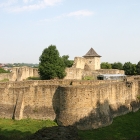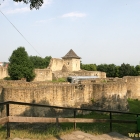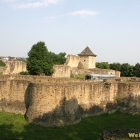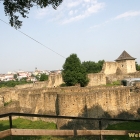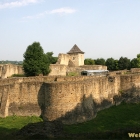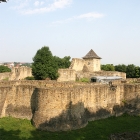The royal fortress of Suceava outlasted the walls of Constantinople
The fall of Constantinople must have been the greatest event in the history of the Middle Ages. Though the Ottoman Empire was already spread around the town, it was thought that its walls were impenetrable. It was the greatest city of its time, in an age when Paris was a collection of villages and Rome was sacked by barbarian tribes. The sultan who gained the glory of taking the capital of the Byzantine Empire was Mehmed the II, and 23 years after he reached the walls of this Moldavian fortress.
And the walls of the fortress of Stephen the Great withstood the assault. It was the place from where Moldova was ruled at least from 1388, as far as the documents tell us, during the time of Petru Musat I. The citadel was both a royal residence and a fortress against foreign armies. Inside the walls there were a castle and a yard with cellars for provisions. Every king added new ditches and concentric walls, some as thick as two meters. Most of the work was done during the half of century reign of Stephen the Great.
Moldova is a historic region of Romania that was divided first by the Tsarist empire by taking away the western part, Basarabia. Through the Ribentropp – Molotov pact, signed by the foreign affairs of Hitler and Stalin, Moldova was once again parted. The western part, over river Prut, once part of the Soviet Union, is now an independent state named Moldova. The most of moldavians still live in Romania, West of river Prut. They share the same language, traditions and the same respect for Stephen the Great and other historic figures. In the republic of Moldova there is a similar fortress named Soroca, from the same medieval age.
The fall of the fortress of Suceava came during the reign of Petru Rares. Though a great king and builder of important landmark churches, Petru Rares allowed the armies of Suleiman the Magnificent. One of his successors, Alexandru Lapusneanu even agrees to set the fortress on fire in order to assure the Ottomans it will no longer pose an obstacle in their control over the land.
Very close to the Royal Fortress there is an interesting Village Museum dedicated to dwellings and crafts in Bukovina.
- Home Page
start page - Architecture
landmark buildings - Sacred architecture
places of worship - Nature
landscape photography - Concert
performing artists - Christmas
Santa Claus pictures
- Jooble
jobs for photographers - Escape
an out of control blog - Merry Christmas
The best organizer of Christmas parties - Astro photo
Eclipse hunting and astrological photography



